Travels in Mexico
Chichén Itzá
|
Sacred city of the Maya One mandatory stop on our planned travels while in Mexico was Chichén Itzá, a city standing in testimony to the splendor of the ancient Maya. At a time when Europe was languishing in the Dark Ages, this gifted people reached the peak of its development with one of the most complex civilizations to exist. They had a knowledge of medicine, astronomy, mathematics and the measurement of time that placed them far ahead of their contemporaries elsewhere in the world. |
|
El Castillo or Pyramid of Kukulcán, right, the tallest structure at the archeological site, is visible for miles around on the limestone plain of the Yucatán. It stands 30 meters or nearly 100 feet, dominating the Great Plaza. The Castillo is so precisely aligned that it acts as a solar calendar, marking the seasons, pinpointing the equinox and solstice. Keep in mind this was done by a people with only stone tools while Europe was in the Dark Ages. The most impressive display of this precision engineering occurs each year on the equinox when shadows cast by the sun directly over the equator crawl down the north-face staircase. |
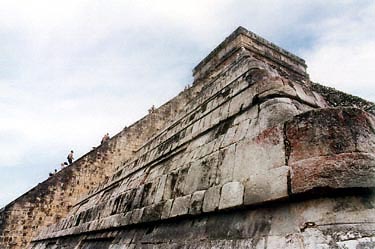 Photo by Bill McKee |
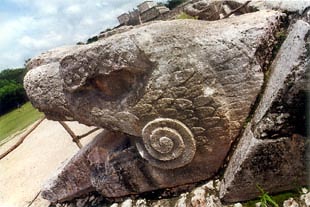 Photo by Bill McKee |
This effect of light and shadow, enhanced by the large serpent heads, left, at the base of the staircase, make it appear as if Kukulcán, depicted as a feathered serpent, was descending the steps. The event begins about 3 p.m. and lasts a maximum of two hours. The spring equinox draws the biggest crowds due to perfect weather. The fall event is less popular given the possibility of rain.
|
|
People from around the world climb the 91 steep, slippery steps leading to the platform on top which stands nearly 100 feet tall. High above the Great Plaza, atop El Castillo, sometimes also referred to as the pyramid of the sun, visitors can see for miles in every direction across the vast jungle on the limestone plain of the Yucatán.
|
 Photo by Bill McKee |
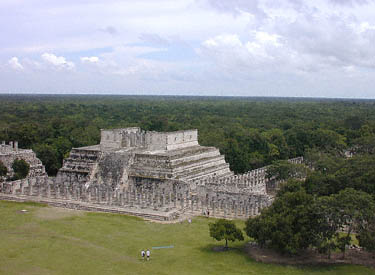 Photo by Patsy McKee |
One of the prominent views greeting those brave enough to climb this staircase of the serpent, is the Temple of the Warriors behind which can be seen a small part of the jungle. This structure, left, is flanked on the front and south sides by columns known as Colonnades and Court of The Thousand Columns. |
 Photo by Patsy McKee |
Walking among the columns on the south side of the court, left, surrounded by a low wall fitted with benches, we came to an area known as The Market. The columns on the front, or northwest
side, right, are a gallery of notables carved in stone, along
the route one took to reach The Temple of the Warriors. |
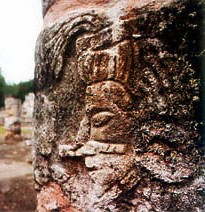 Photo by Bill McKee |
| These columns leading to the temple are constructed from, stacks of rounded drums, or square blocks. |
 Photo by Patsy McKee |
On them can be found portraits of priests, members of the ruling class, warriors in their prime and veterans. |
 Photo by Bill McKee |
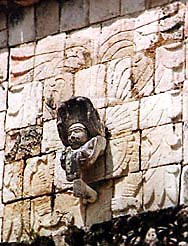 Photo by Bill McKee |
| The walk to the Nunnery, top left, offered a respite among the cool foliage from the sun and heat. Kukulcán, know as 'the Feathered Serpent', above right, can be found throughout the entire city. |
| With a spiral staircase and round
tower the Observatory is different from the rest of the architecture
at Chichén Itzá. The structure appears to facilitate
(among other things) observation of Venus, the planet identified
with Quetzalcoatl- Kukulcán. |
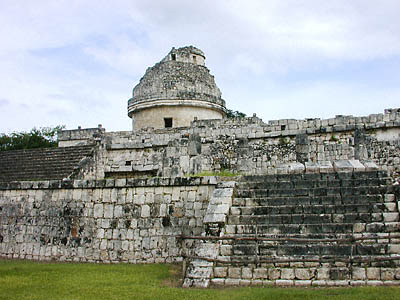 Photo by Patsy McKee |
The Observatory is a round
tower on a square terrace, which itself sits on a much larger,
rectangular platform. The terrace has two half-moon wells that
when filled with water reflected the heavens, making observation
that much easier. All platform staircases face west.*
|
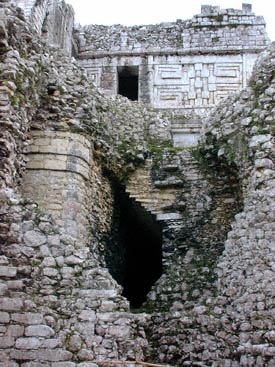 Photo by Patsy McKee |
The Nunnery Group includes the Nunnery, left, its Annex (or East Annex), the so-called Iglesia ('church') and the Akab Dzib. The group is located south of the Observatory but in the same area, one complex clearly visible from the other. The group is often referred to simply as Las Monjas ('the nuns').* The Nunnery is the most complex Late Classic structure at Chichén Itzá and possibly the earliest (7th century). Over a period of three centuries (8th-11th), it underwent seven stages of construction and doubled in size. In its day it was brightly painted both inside and out, and many of its rooms had murals; those of Room 22 are still visible.* It is built in the Puuc tradition , deviating from the classic style of western Yucatán in only one detail. Hallmark Puuc construction calls for rubble walls finished by precision veneer work, and most of Chichén's Puuc-style architecture has plain, unadorned, block-masonry wall. The outstanding exception is the Annex.* |
| This is my favorite photograph of all the ones I shot at Chichén Itzá. The mid-afternoon light and shadows show some of the beauty of the city and the surrounding region of the Yucatán. In the shadows you can also see the precision with which the stones were cut and aligned. |
 Photo by Bill McKee |
As a bit of advice for any seeking to visit Chichén Itzá we would highly recommend a two-day stay for this site alone. |
|
The site can be covered in a day, but, a leisurely pace over two days plus experiencing the Light and Sound Show which takes place twice nightly, once in Spanish and once in English, under the stars which imbues Chichén with the drama it deserves. *Colección Verás, Chichén Itzá, Yucatán Mexico, Map and Visitor's Guide. |
|
Any comments or suggestions can be sent to
us
through our Mail Basket (below): |

